
Humu has an attitude! Very territorial and will charge a snorkeler. Rich can tell you all about it.
I call him Mr. Blue Lips.
I call him Mr. Blue Lips.
The reef, rectangular, or wedge-tail triggerfish, also known by its Hawaiian name, humuhumunukunukuāpuaʻa, or just humuhumu for short; meaning "triggerfish with a snout like a pig"), is one of several species of triggerfish. Classified as Rhinecanthus rectangulus, it is endemic to the salt water coasts of various central and south Pacific Ocean islands. It is often asserted that the Hawaiian name is one of the longest words in the Hawaiian Language and that "the name is longer than the fish."
The triggerfish's teeth are blue and they are set close together inside its relatively chubby mouth, it has a small second spine, which it can use to lock its main spine into an upright position. The triggerfish can wedge itself into small crevices and lock its spine to make it extremely difficult to get out. In addition, when fleeing from predators, the triggerfish will sometimes make grunting noises, possibly a call to warn other nearby triggerfish of danger at hand.
Triggers have the remarkable ability to rapidly alter their coloration. They can fade into a relatively drab appearance when sleeping or demonstrating submission while the coloration is often the most vivid when the fish is healthy and unthreatened by its surrounding.
One particularly interesting aspect of the fish's behavior is the ability to blow jets of water from its mouth. These jets help the fish find benthic invertebrates that may be buried under the substrate. Triggerfish can often be seen spitting sand from their mouths in order to sift through the material in search of edible detritus or organisms. Reef triggers are fairly aggressive and will generally not tolerate conspecific species in its general vicinity, thus the fish is often found solitary. This is particularly true in captivity. Triggers have the remarkable ability to rapidly alter their coloration. They can fade into a relatively drab appearance when sleeping or demonstrating submission while the coloration is often the most vivid when the fish is healthy and unthreatened by its surroundings.

No comments:
Post a Comment